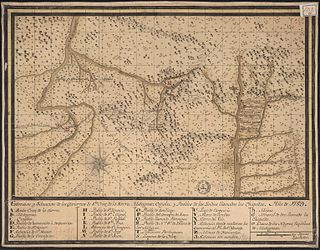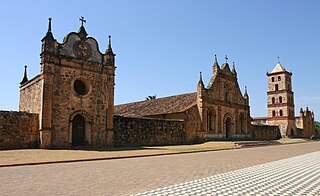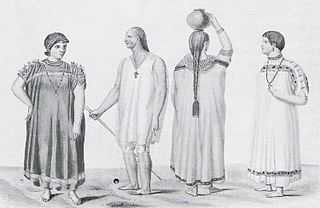The following table summarizes the history of foundings and relocations of the Jesuit Missions of Chiquitos. [1] [2]
The following table summarizes the history of foundings and relocations of the Jesuit Missions of Chiquitos. [1] [2]

Chiquitania is a region of tropical savannas in the Santa Cruz Department in eastern Bolivia.

The Jesuit missions among the Guaraní were a type of settlement for the Guaraní people in an area straddling the borders of present-day Argentina, Brazil and Paraguay. The missions were established by the Jesuit Order of the Catholic Church early in the 17th century and ended in the late 18th century after the expulsion of the Jesuit order from the Americas. The missions have been called an experiment in "socialist theocracy" or a rare example of "benign colonialism". Others have argued that "the Jesuits took away the Indians' freedom, forced them to radically change their lifestyle, physically abused them, and subjected them to disease".
Chiquitano is an indigenous language isolate spoken in the central region of Santa Cruz Department of eastern Bolivia and the state of Mato Grosso in Brazil.

San Ignacio de Velasco, is the capital of the José Miguel de Velasco Province and the San Ignacio de Velasco Municipality in the Santa Cruz Department of Bolivia.

Concepción is a town in the lowlands of eastern Bolivia. It is known as part of the Jesuit Missions of Chiquitos, declared in 1990 a World Heritage Site, as a former Jesuit Reduction.

The Jesuit Missions of Chiquitos are located in Santa Cruz department in eastern Bolivia. Six of these former missions collectively were designated as a UNESCO World Heritage Site in 1990. Distinguished by a unique fusion of European and Amerindian cultural influences, the missions were founded as reductions or reducciones de indios by Jesuits in the 17th and 18th centuries to convert local tribes to Christianity.

San Rafael de Velasco or San Rafael is the seat of the San Rafael Municipality in the José Miguel de Velasco Province, Santa Cruz Department, Bolivia. It is part of the Jesuit Missions of Chiquitos. In 1990 it was declared a World Heritage Site.

San José de Chiquitos or simply San José is the capital of Chiquitos Province in the Santa Cruz Department, Bolivia. It is known as part of the Jesuit Missions of the Chiquitos, which is declared in 1990 a World Heritage Site, as a former Jesuit Reduction.

San Javier is the seat of San Javier Municipality in Ñuflo de Chávez Province, Santa Cruz Department, Bolivia. The mission of San Javier is known as part of the Jesuit Missions of the Chiquitos, declared in 1990 a World Heritage Site, as a former Jesuit Reduction.

San Miguel de Velasco or simply San Miguel is a town in the Santa Cruz Department, Bolivia. It is the capital of San Miguel Municipality, the second municipal section of José Miguel de Velasco Province. It is known as part of the Jesuit Missions of the Chiquitos, which was declared a World Heritage Site in 1990, as a former Jesuit Reduction. The wood and adobe church has an elaborate interior.

Santa Ana de Velasco is a small town in the Santa Cruz Department, Bolivia.
Gorgotoqui is a currently undocumented extinct language of the Chiquitania region of the eastern Bolivian lowlands. It may have been a Bororoan language.

Martin Schmid, also known as Esmid was a Swiss Jesuit, missionary, musician and architect, who worked mainly in the Chiquitos Province of what is now Bolivia.

The Chiquitano or Chiquitos are an indigenous people of Bolivia, with a small number also living in Brazil. The Chiquitano primarily live in the Chiquitania tropical savanna of Santa Cruz Department, Bolivia, with a small number also living in Beni Department and in Mato Grosso, Brazil. In the 2012 census, self-identified Chiquitanos made up 1.45% of the total Bolivian population or 145,653 people, the largest number of any lowland ethnic group. A relatively small proportion of Bolivian Chiquitanos speak the Chiquitano language. Many reported to the census that they neither speak the language nor learned it as children. The Chiquitano ethnicity emerged among socially and linguistically diverse populations required to speak a common language by the Jesuit Missions of Chiquitos.

Otuke is an extinct language of the Macro-Jê family, related to Bororo. Otuke territory included what is now the Otuquis National Park and Integrated Management Natural Area in eastern Bolivia.

Santiago de Chiquitos is a small town in Roboré Municipality in Chiquitos Province, Santa Cruz Department, Bolivia. The mission of Santiago de Chiquitos is one of the Jesuit Missions of the Chiquitos.
San Juan de Taperas is a village in San José de Chiquitos Municipality in Chiquitos Province, Santa Cruz Department, Bolivia. The ruins of the mission of San Juan Bautista, one of the Jesuit Missions of the Chiquitos, lie near the village. Since only the ruins of a stone tower survive near the present village of San Juan de Taperas, San Juan Bautista is not one of the six Jesuit Missions of Chiquitos recognized as UNESCO World Heritage Sites.
Santo Corazón is a village in San Matías Municipality in Ángel Sandoval Province, Santa Cruz Department, eastern Bolivia. The mission of Santo Corazón is one of the Jesuit Missions of the Chiquitos.
San Ignacio de Zamucos or San Ignacio was a Jesuit mission in Santa Cruz Department, Bolivia that was founded in 1724 and abandoned in 1745. The inhabitants of the mission were the Zamucoan-speaking Ayoreo.